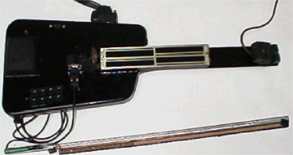|
1. Introduction
I have been working numerous compositions and performances
with Virtual Musical Instruments. These refer to a system
that a gesture of performer is translated into electric signals.
One may control sound or video image of computer with movement
of body in real time.

2. Virtual Musical Instrument
Virtual Musical Instrument, or controllers, cannot produce
sounds by themselves. They merely send signals that produce
sounds by means of a computer or a sound module. They may
be regarded as an interface between the performer and the
computer insofar as they translate the energy derived from
body movements into electrical signals. At the same time however,
they allow the performer to express complex musical ideas.
With the help of a controller, a tiny gesture can trigger
any number of complex musical passages at one and the same
time in a real time context, whereas a traditional instrument
can produce only a limited range of sounds.

3. SuperPolm
One of Virtual Musical Instrument that I created is Virtual
Violin “SuperPolm”. There is neither string nor
hair of bow. A gesture of performance with a violin is merely
modeled.
The SuperPolm is played in a similar manner to the violin,
except that the fingers touch sensors on a finger board instead
of pressing strings. Sounds may also be modified by movements
of the bow, which records variations in resistance. An eight-button
keyboard situated on the body of the instrument can change
both the program and the sounds as well as triggering different
pitches, like a normal keyboard.
The SuperPolm was built in such a way as to respond to body
movements. However it can be assigned new functions by programming,
so as to take into account the compositional needs of each
piece : for instance a sensor can be used to trigger sounds
in one composition, whereas in another it can be used to change
the pitch.
The basic idea behind the SuperPolm is to interface gestures
that resemble the playing of a musical instrument in order
to control sound or images. These gestures are translated
into parameters of position, pressure or distance by sensors.
The resulting voltage is converted by an analogue to digital
interface into MIDI signals that can be fed into a computer.
The computer controls or generates the sounds in real time
and can modify these signals by means of algorithms. For example
a single channel signal can be altered to become a rich and
complex sound, such as an orchestral sound.
The SuperPolm can also control the parameters of images in
real time. For instance, it can superimpose live or sampled
images on top of each other, add effects, such as delay, and
speed up, reverse or repeat these images. It can also mix
several images in different proportions and modify their color,
brightness and distortion, while the sampled images can be
started and stopped at any point.

The SuperPolm was built in 1996 . It was originally intended
for use in a piece I composed for IRCAM in 1995 - 1996, entitled
"VirtualAERI". The first performance of this piece
was given in 1997 at IRCAM's Espace de Projection, in Paris,
France. It consisted of four sections, each of which dealt
with a different kind of space, large, medium and small. The
SuperPolm was designed as an interface for small-scale gestures,
and one particular section of the composition focused specifically
on the possibilities opened up by the controller.

|

